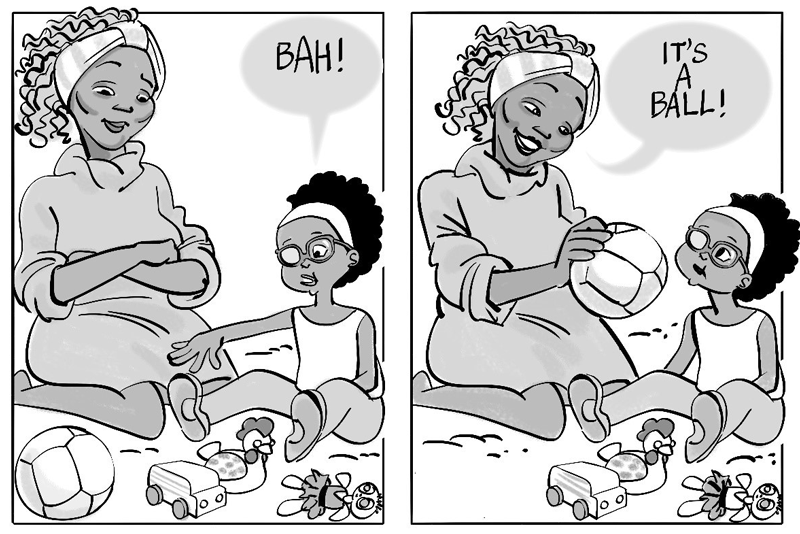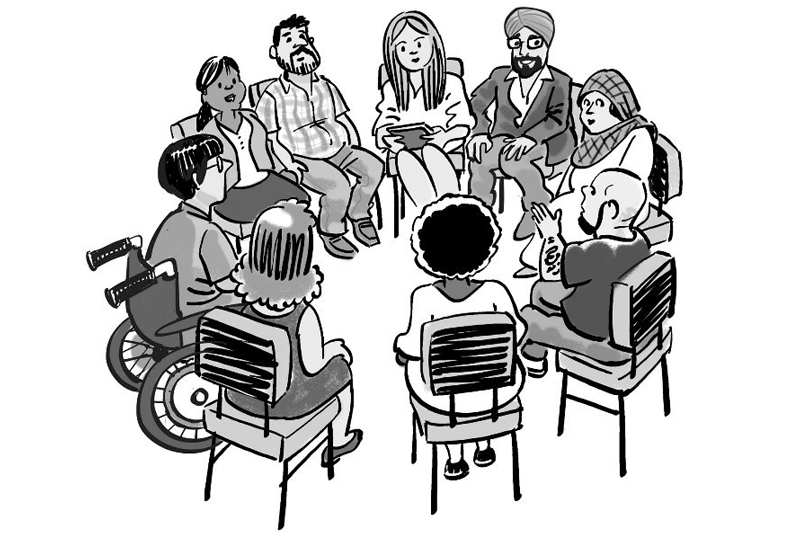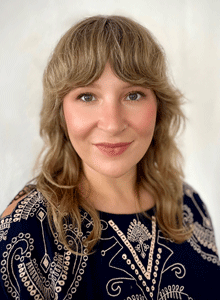When Mukri Yilma noticed her son Kibur’s use of words and gestures starting to fade at 22 months, she knew something was wrong. Suddenly, he was not waving “hi” or pointing at airplanes anymore, and he stopped using words that had been part of his vocabulary.
Concerned, Mukri took Kibur to his pediatrician, where a screening found that he was at high risk for autism. A developmental pediatrician confirmed Kibur’s autism diagnosis—and Mukri’s search for early intervention services began.

“Respond and expand” is a core Caregiver Skills Training strategy to improve communication skills.
“Going into the pediatrician, I already suspected that he was on the autism spectrum,” says Mukri. “I couldn’t really face my emotions at the time because I felt like if I lingered in my own emotions, I wouldn’t be successful in getting him what he needed. But my thinking was so wrong because these things don’t just go away—they come back much bigger if you don’t deal with them right away.”
Soon after Kibur’s diagnosis, Mukri signed up for the World Health Organization’s Caregiver Skills Training (CST) program, supported by Autism Speaks. Run by the Ethiopian Eritrean Special Needs Community (EESNC), a local organization serving Ethiopian families in Maryland, the program was a turning point for her family.
What is Caregiver Skills Training (CST)?
CST is an evidence-based, parent-mediated intervention designed for parents and caregivers of children with developmental disorders, including autism, between the ages of 2 and 9 (World Health Organization, 2022). Delivered in 12 sessions, including nine group training sessions and three home visits, the program teaches caregivers how to use everyday play and home routines as opportunities to build their child’s communication, engagement, positive behavior, and daily living skills, all at no cost to families (World Health Organization, 2022; Salomone et al., 2019).
Research shows that the strategies taught in CST help children with developmental delays build critical communication and emotional regulation skills while also increasing caregiver confidence and self-efficacy and reducing stress (Seng et al., 2022; Sengupta et al., 2023; Salomone et al., 2022a, 2022b; Tekola et al., 2019).
“CST taught me the best way possible to help my child grow,” says Mukri. “I learned how to play with him, how to manage his challenging behaviors, and how to manage my own emotions. I started seeing the best of him when my husband and I changed our strategies. I think this program is very important because it closes the gap between now and when you get services. If services are interrupted, you still have some knowledge to do what you need to do to support your child.”
Today, Mukri is a CST trainer and an advocate for other parents walking the same path. Here are some of the practical strategies she learned through CST and how they impacted her family.
Building Engagement Through Child-Led Play
Mukri initially struggled to connect with her son through play. Growing up in Ethiopia, play between children was common, while parents were more involved with their child’s education. Through CST, she learned the importance of play in fostering her son’s development.
“One of the most important lessons that I learned was about play,” says Mukri. “I learned to declutter—to have an area just for me and my son to play—and to let him lead the play. I set aside time every day to engage with him one-on-one. It’s not a lot of time, sometimes just 10 or 15 minutes, but spending that time together without any interruption is one of the most important lessons.”
CST encourages caregivers to simplify their play area, offering just two or three activities and letting the child choose the one they prefer. For example, a parent might hold up a picture book in one hand and blocks in the other, observing which the child selects through their gaze, gestures, or words.
“CST focuses on helping parents to pay attention to what their child is interested in,” says Pamela Dixon, Ph.D., director of clinical services and inclusion at Autism Speaks. “We call it ‘look and listen.’ They’re taught to follow the child’s gaze and to follow that as an area of play. The reason for that is people are more likely to spend time doing things that they like. The intention is to spend as much time as possible engaged with the child because we have research that shows joint engagement promotes language development.”
Expanding Language Step-By-Step
Once a child is engaged in joint play, parents can help them build language skills by imitating their play while pairing language with the action.
“If the child is playing with blocks and tries to say the word ‘block’ but can only say ‘b,’ the parent builds on that and says ‘block,’” explains Dr. Dixon. “If the child has more language and says ‘train,’ the adult would add another word—’train go.’ The idea is to imitate the child and expand on what the child is saying.”
Dr. Dixon describes this as “respond and expand,” a core CST strategy. Using gestures is also an important part of this process. If a child uses one word, a parent might use two and combine it with a gesture like a finger point or an open palm.
This method has been very effective in improving Kibur’s communication skills. Murki says that when they first started CST, Kibur could only speak in one-word responses. She learned to gently build on his attempts by modeling slightly more advanced language.

Caregiver Skills Training brings together parents and caregivers in a supportive learning environment.
“I learned to set a goal based on my child’s level of communication. So, if he was using one word, our goal would be to use two words. If he said, ‘water,’ I’d respond with, ‘drink water.’ Over time, he learned to say full sentences,” she explained.
Understanding the Communication Behind Behavior
CST also taught Mukri to reframe her understanding of meltdowns and other challenging behaviors. The program teaches that behavior is a type of communication, so understanding the cause of the behavior is critical to reducing it.
“You can do that by going back to the earliest skill we teach, which is ‘look and listen,’” explains Dr. Dixon. “Pay attention to why the behavior is happening. It could be to get a need met, express discomfort, or communicate a want. By observing the child and paying attention to what they’re looking at, you can get a sense of why that behavior is occurring and then match an intervention or a strategy with that behavior.”
For example, if a child frequently has meltdowns in a certain aisle in the grocery store, it might be because they want something. With this knowledge in hand, parents can choose to avoid that aisle or give the child something to hold so that they have a distraction.
If the meltdown still occurs, the best thing to do is provide a calming presence—be quiet and let it pass. “Parents need to learn to regulate their own emotions first, as children mirror their caregivers’ responses,” says Dr. Dixon. “This soothing presence helps de-escalate situations.”
One helpful tool that CST teaches for emotional regulation is imagining a “behavior thermometer” with three levels: cool, warm, and hot. When a child is cool, they are alert but not overstimulated. Warm means that they are beginning to become dysregulated, and hot is a full-blown tantrum or other challenging behavior. By observing their child’s behavior when they are cool, caregivers can see the signs of an incoming meltdown and intervene.
“Sometimes, when Kibur is having a behavioral problem, I just want to pick him up and hold him because comforting him helps comfort me. But I’ve learned that actually makes things worse,” says Mukri. “Now, when he is having a meltdown, the first thing I do is check in with myself and take a deep breath. Then, I try to understand what happened before that behavior. Over time, you become a mini parent scientist because you’re collecting data on what’s happening before the behavior, and you begin to see trends. Then, you can work with therapists to intervene.”
The Impact of CST
The transformation Mukri and her son have experienced after participating in CST has been profound. Her son now speaks in full-length sentences, plays with his younger brother, engages with his family, and advocates for himself.
“I see so much progress in Kibur’s communication skills, behavior, emotional regulation, and everything else. And I see changes in myself and my husband. We are much more understanding and aware of Kibur’s needs, and we are setting aside time for self-care so we can be strong and healthy for our kids.”
CST has also helped Mukri become a better advocate for Kibur. “Because we have this special time bonding, it helped me know his weaknesses and his strengths, and it gave me a voice during his IEP meetings and therapy evaluations. It propelled me to be a better advocate and, most importantly, a voice for my son.”
Marta Chmielowicz leads science communications at Autism Speaks, working to advance the mission of the organization to create an inclusive world for all individuals with autism throughout their lifespan. For more information, email marta.chmielowicz@autismspeaks.org or visit autismspeaks.org.
References
Salomone, E., Ferrante, C., Salandin, A., Ferrara, F., Torchio, E., Foletti, G., Ghersi, S., Pacione, L., & Servili, C. (2022). Acceptability and feasibility of the World Health Organization’s Caregiver Skills Training implemented in the Italian National Health System. Autism, 26(4), 859-874. https://doi.org/10.1177/13623613211035228
Salomone, E., Pacione, L., Shire, S., Brown, F. L., Reichow, B., & Servili, C. (2019). Development of the WHO Caregiver Skills Training Program for Developmental Disorders or Delays. Frontiers in psychiatry, 10, 769. https://doi.org/10.3389/fpsyt.2019.00769
Salomone, E., Settanni, M., McConachie, H., Suma, K., Ferrara, F., Foletti, G., Salandin, A., WHO CST Team, Servili, C., & Adamson, L. B. (2022). Pilot Randomized Controlled Trial of the WHO Caregiver Skills Training in Public Health Services in Italy. Journal of autism and developmental disorders, 52(10), 4286–4300. https://doi.org/10.1007/s10803-021-05297-x
Seng, G. J., Chiu, Y. N., Tsai, W. C., Lin, H. Y., Li, S. C., Hsiao, M. N., Liu, T. J., Chen, H. M., Shih, A., Chang, Y. C., Who Cst Team, & Soong, W. T. (2022). Promotion and implementation effectiveness of World Health Organization’s Caregiver Skills Training program in Taiwan. Frontiers in psychiatry, 13, 904380. https://doi.org/10.3389/fpsyt.2022.904380
Sengupta, K., Shah, H., Ghosh, S., Sanghvi, D., Mahadik, S., Dani, A., Deshmukh, O., Pacione, L., Dixon, P., Salomone, E., WHO-CST team, & Servili, C. (2023). World Health Organisation-Caregiver Skills Training (WHO-CST) Program: Feasibility of Delivery by Non-Specialist Providers in Real-world Urban Settings in India. Journal of autism and developmental disorders, 53(4), 1444–1461. https://doi.org/10.1007/s10803-021-05367-0
Tekola, B., Girma, F., Kinfe, M., Abdurahman, R., Tesfaye, M., Yenus, Z., Salomone, E., Pacione, L., Fekadu, A., Servili, C., Hanlon, C., & Hoekstra, R. A. (2020). Adapting and pre-testing the World Health Organization’s Caregiver Skills Training program for autism and other developmental disorders in a very low-resource setting: Findings from Ethiopia. Autism, 24(1), 51-63. https://doi.org/10.1177/1362361319848532
World Health Organization. (2022). Caregiver skills training for families of children with developmental delays or disabilities: Introduction. https://iris.who.int/bitstream/handle/10665/353579/9789240048836-eng.pdf?sequence=1






